With the government encouraging new car buyers towards electric and plug-in hybrid cars, the range of electrified models available to us in New Zealand is expanding rapidly. That $5,750 discount off a new PHEV is definitely a bonus. The Escape PHEV is Ford’s contender in the hybrid family SUV market.
I used it for a week’s daily drive, and a weekend road trip to Taranaki, to see how it fared, and how little fuel it would sip.
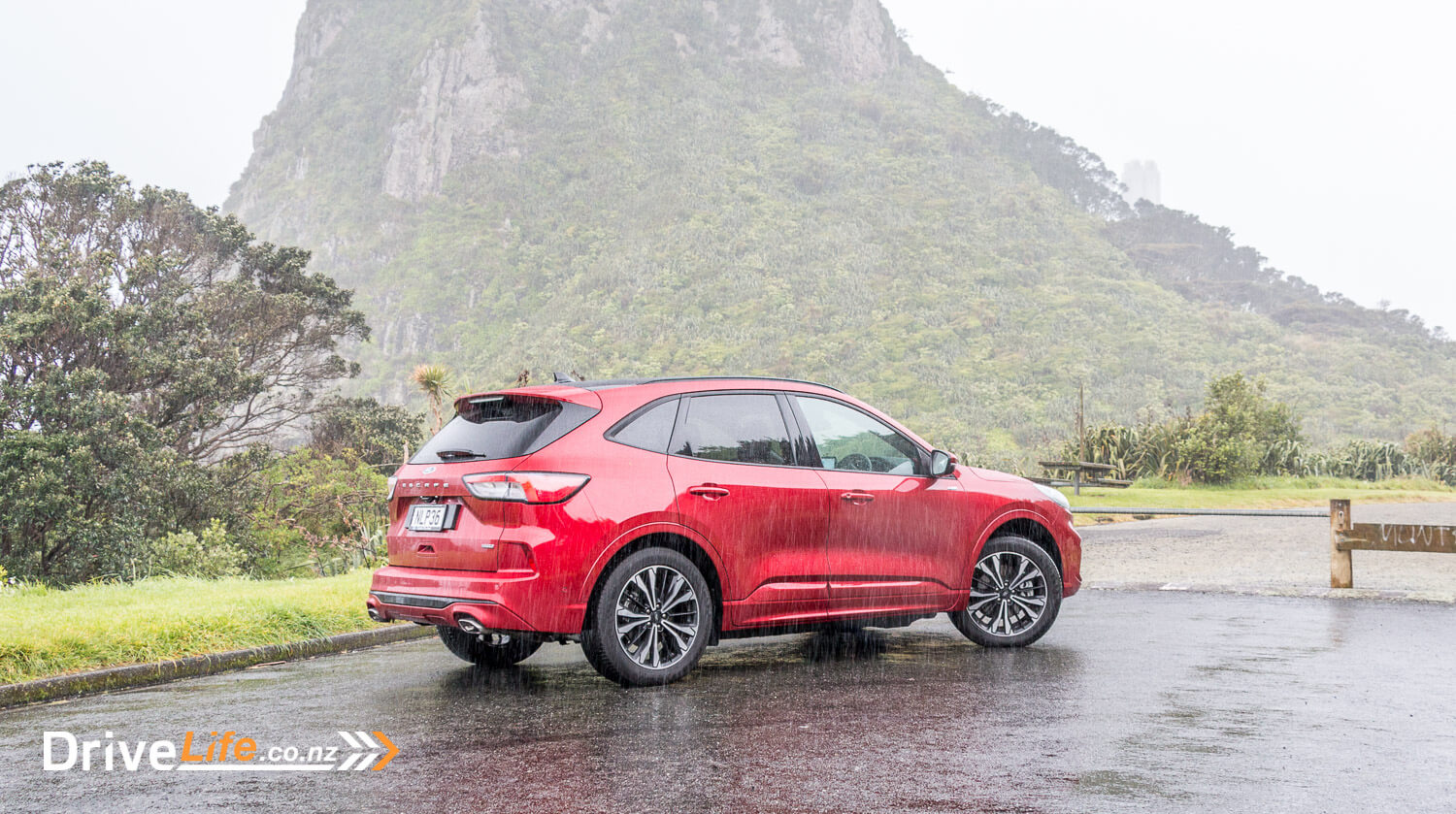
What We Like and Dislike About The Ford Escape ST-Line X PHEV
| What we like | What we don’t like |
| Economy Comfort Fun to drive Looks good Great stereo Equipment levels | Cruise control not the smoothest Brakes grabby at low speeds Auto high-beam could be better |
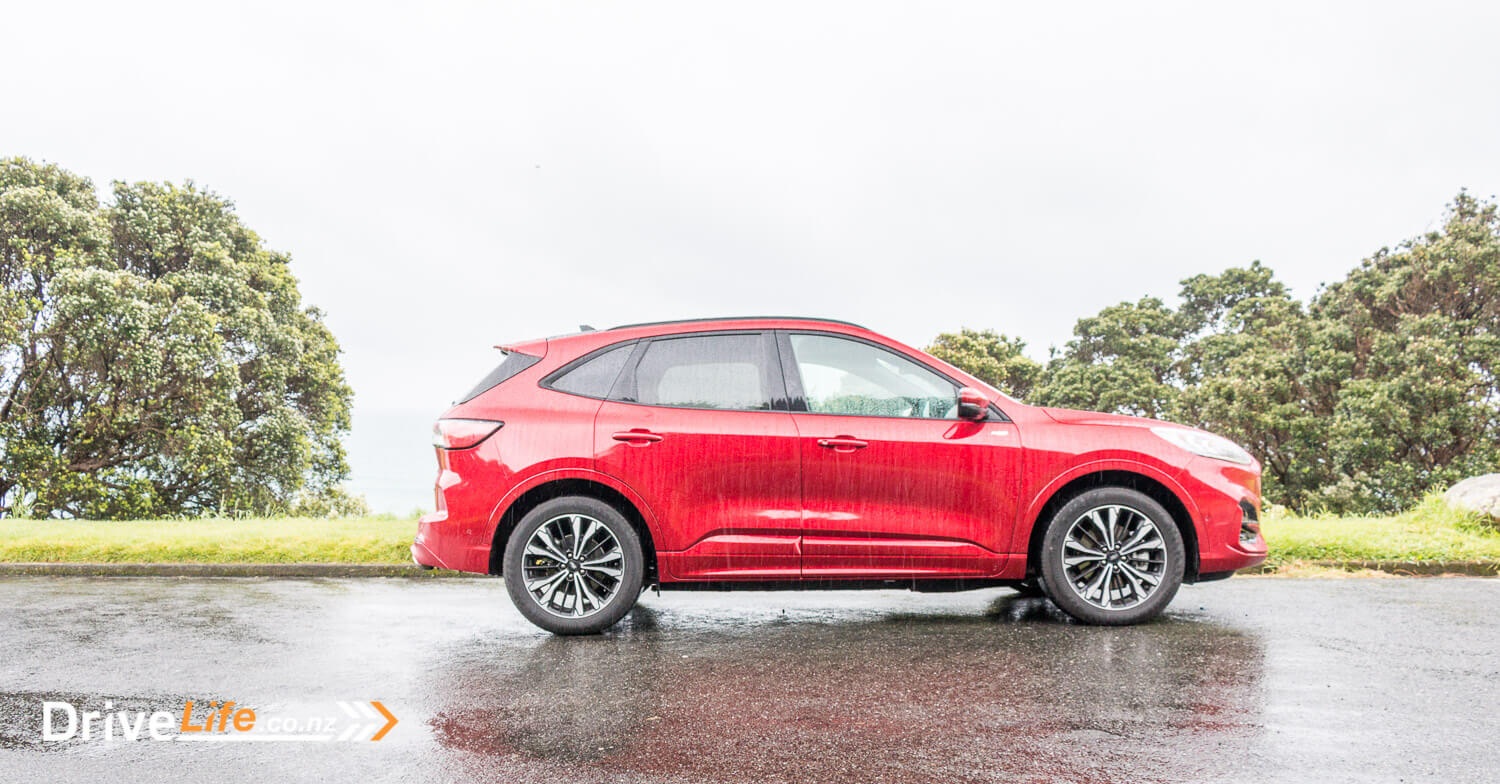
What’s In The Ford Escape Range?
There are four standard-engined options for your Ford Escape, equipped with a 183kW/387Nm 2.0-litre turbocharged petrol engine:
- EcoBoost FWD – $42,990
- EcoBoost ST-Line – $47,990
- EcoBoost ST-Line AWD – $50,990
- EcoBoost ST-Line X AWD – $55,990
Then there are two PHEVs, with a 2.5-litre normally aspirated engine and electric motor with a combined 167kW and 14.4kWh battery capacity giving up to 54km pure-electric range:
- PHEV FWD – $60,990
- ST-Line X FWD PHEV – $66,990
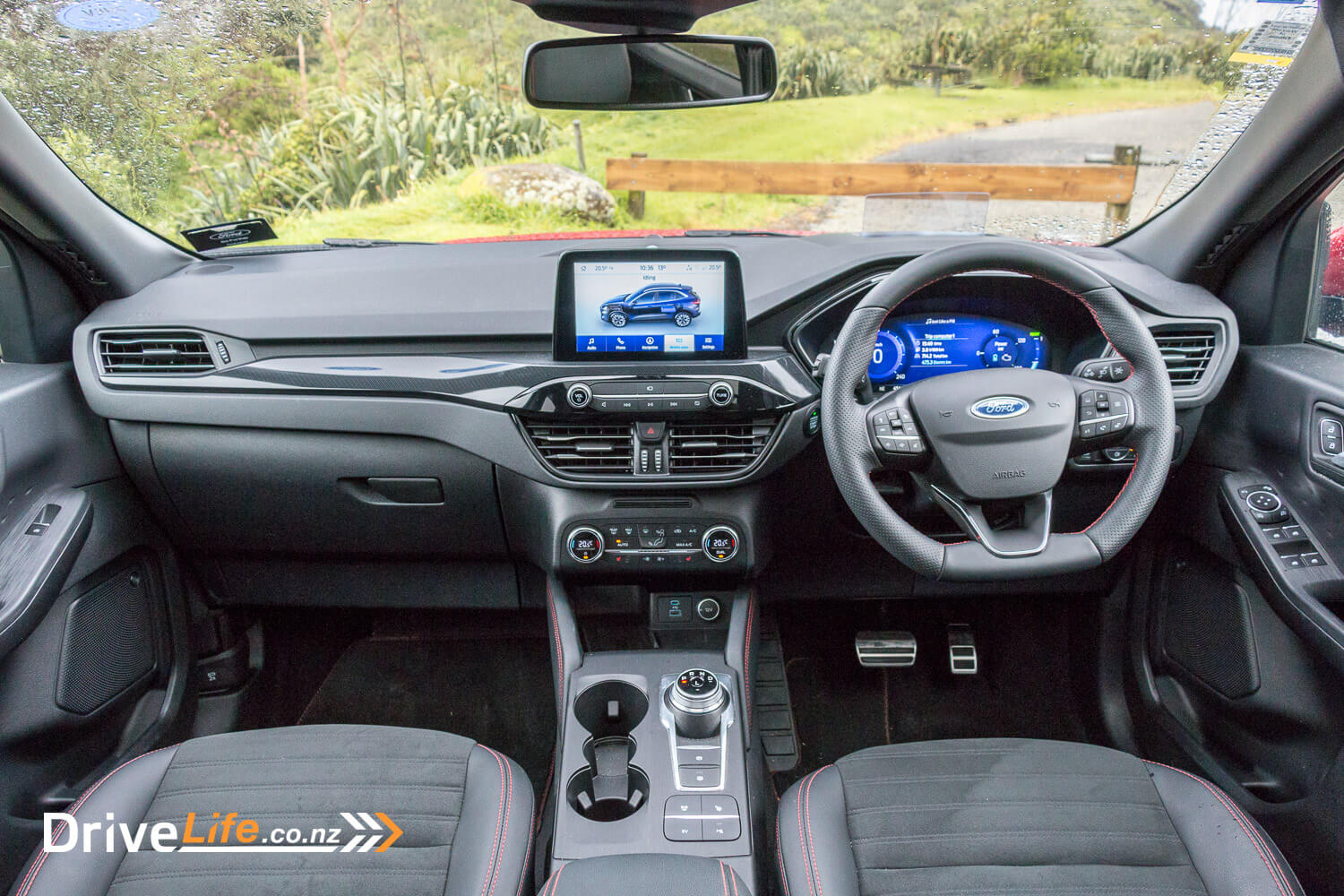
Ford Escape ST-Line X PHEV Standard Equipment Highlights
- Auto start-stop
- Sports-tuned suspension
- 10-speaker B&O audio
- Satnav
- Bluetooth stereo with Apple Carplay and Android Auto
- Wireless phone charger
- Ambient lighting
- Heads-up display
- Panoramic sunroof
- 3-zone climate control
- Auto lights and wipers
- Keyless entry and start
- 19” alloys
- Full LED headlamps with auto main beam
- Electric tailgate
- Adaptive cruise with stop and go
- Blind spot warning
- Evasive Steer Assist
- Parking sensors all-round and 360 camera
- Traffic sign recognition
- Auto Park Assist
- Keyless entry and start
Colours available are:
- Frozen White
- Agate Black
- Solar Silver
- Blue Metallic
- Rapid Red
For a full list of specs and options available for the Ford Escape jump on over to the Ford New Zealand website
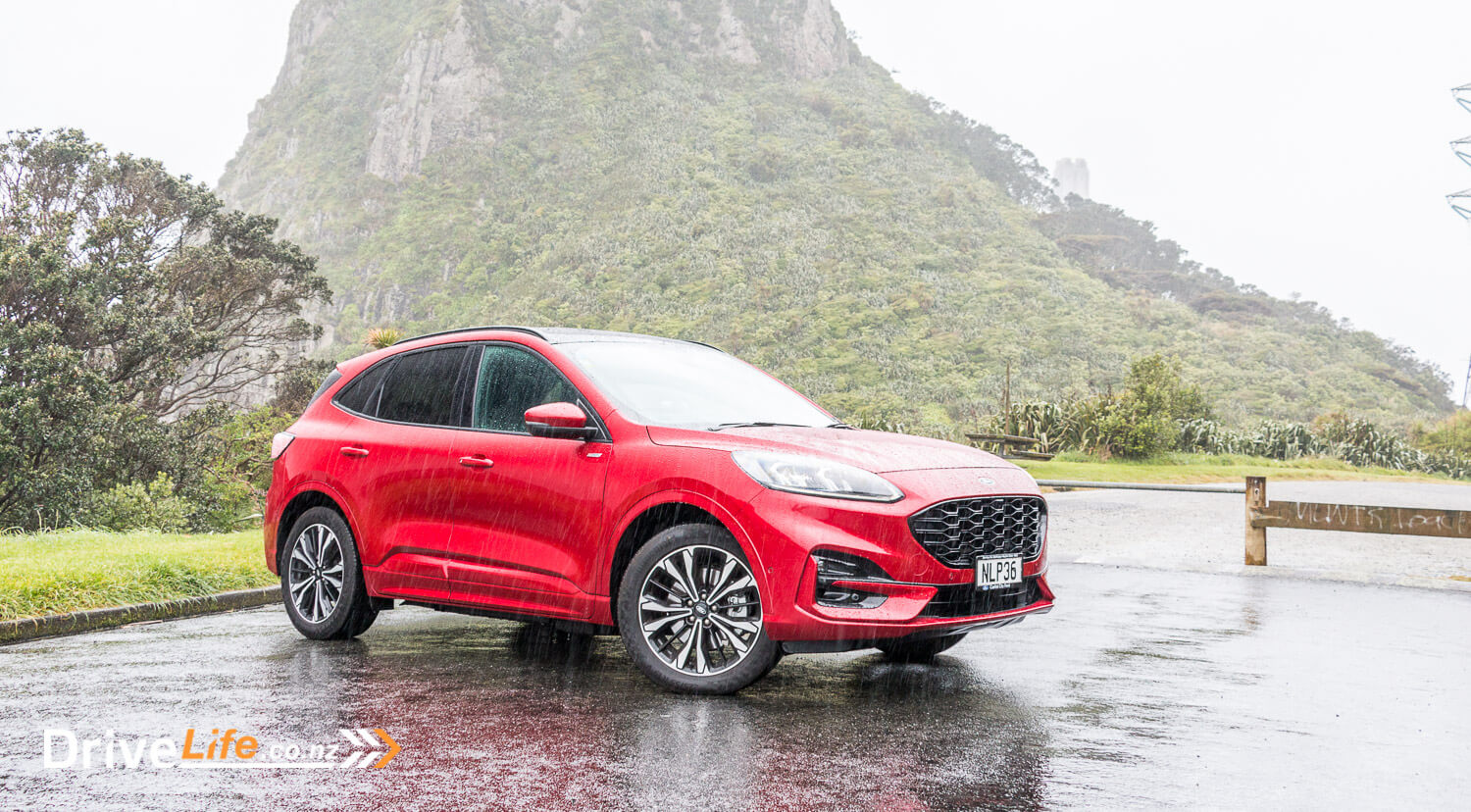
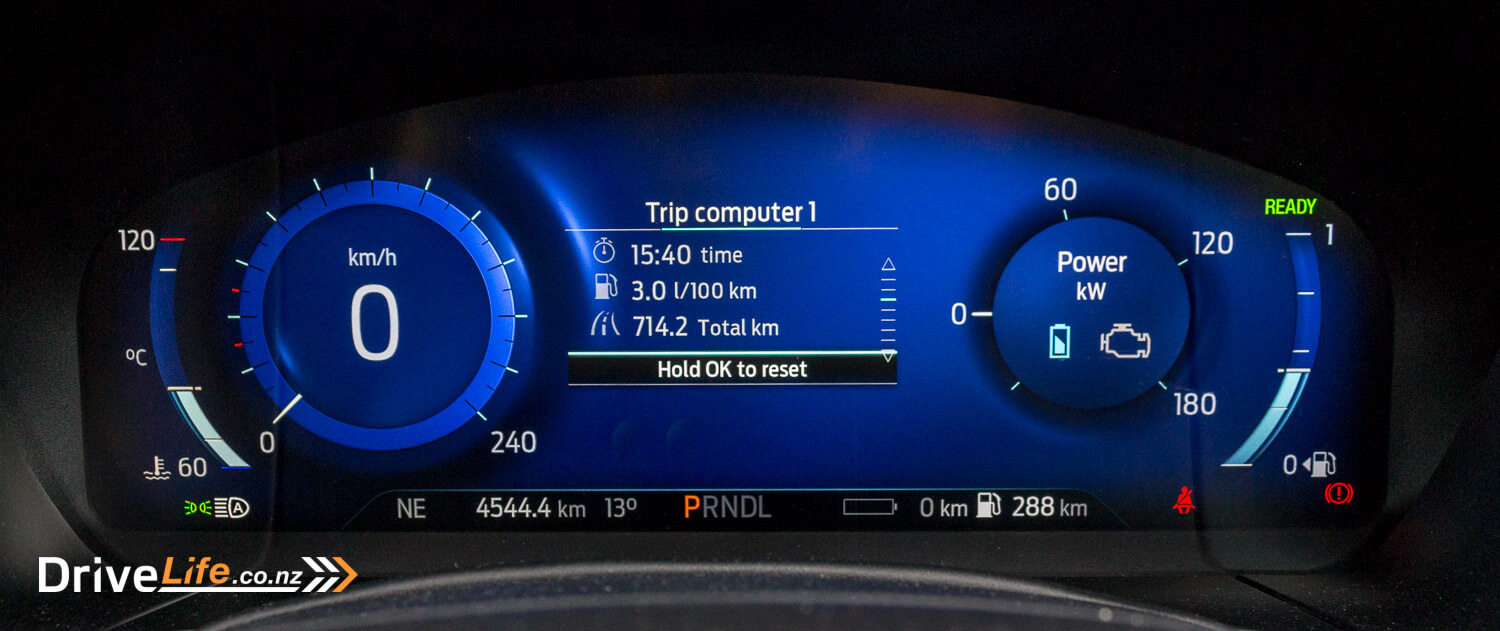
How Does The Ford Escape ST-Line X PHEV Compare To Its Competition?
Right now there’s not a huge amount of competition in the SUV PHEV market. Expect this to explode soon!
| Make/ Model | Engine | Power kW/Nm | Seats | Fuel L/100km | Towing | Boot Space, litres | Price |
| Kia Sorento Plug-In Hybrid EX | 1.6-litre 4-cylinder turbo hybrid electric | 132/265 | 5 | 1.6 | 1500 | 604 | $73,990 |
| Ford Escape ST-Line X PHEV | 2.5-litre 4-cylinder hybrid electric | 167 | 5 | 1.5 | 1200 | 517 | $66,900 |
| Mitsubishi Eclipse Cross PHEV | 2.4-litre 4-cylinder hybrid electric | 94/199 | 5 | 1.9 | 1600 | 404 | $65,990 |
| MG HS PHEV | 1.5-litre 4-cylinder turbo hybrid-electric | 119/250 | 5 | 1.7 | 750 | 451 | $52,990 |
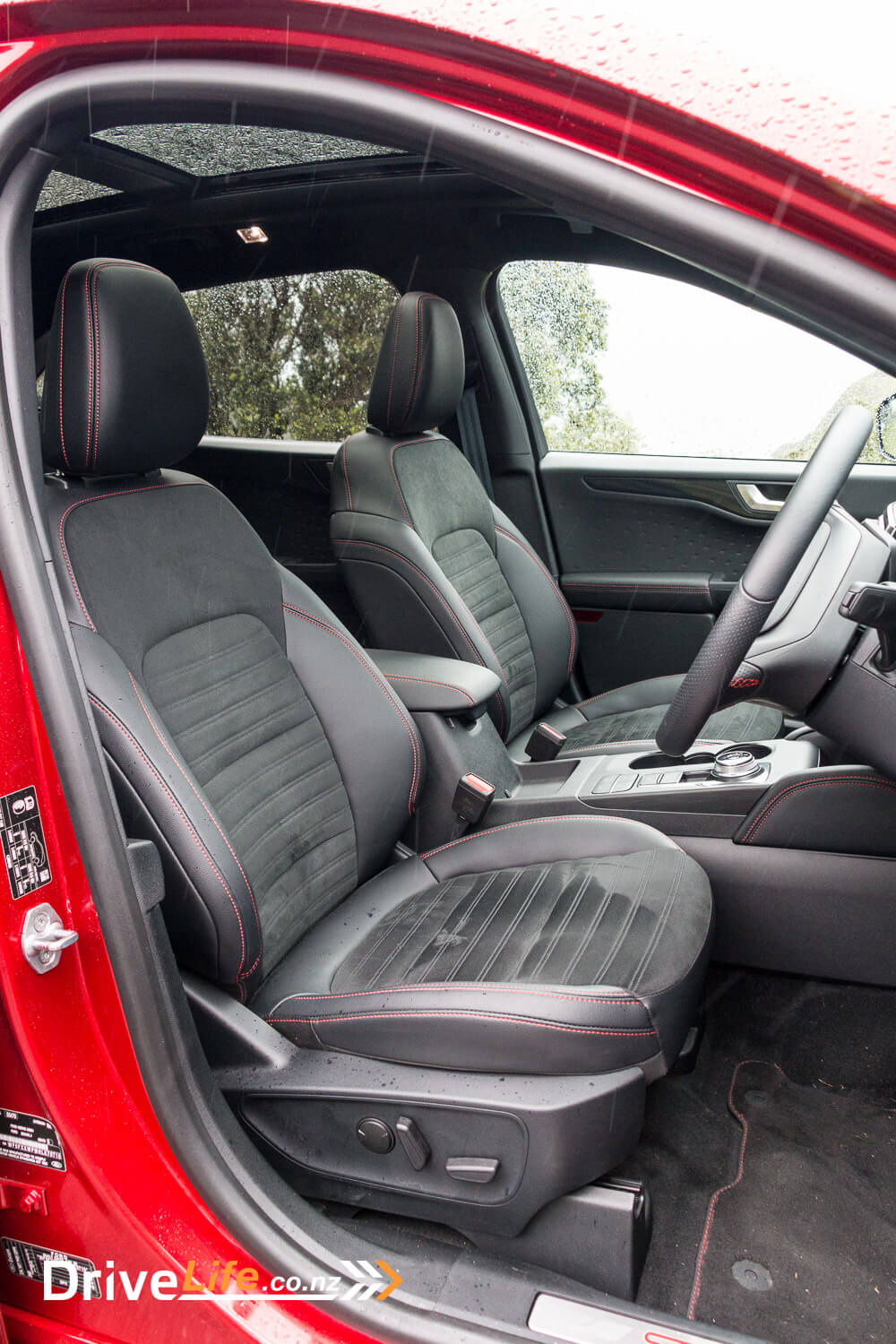
First Impressions Of The Ford Escape ST-Line X PHEV
Our review car came in Rapid Red, which instantly got my approval. You know how we love a proper colour here at DriveLife. It’s a nice, deep metallic red that looks great in the sun. The design? Well it’s very consistent with Ford’s design language of the moment. From the front it could be a larger Puma, which itself could be a larger Fiesta. It has the look of a wide-mouthed, grinning salamander from the front. Not in a bad way though. I like it.
Move to the side and yep, it’s an SUV, nothing outstanding or offensive here. The rear has twin-exhausts for a bit of a sporty look. And overall it’s a good-looking car, though it might blend in somewhat in a Countdown car park.
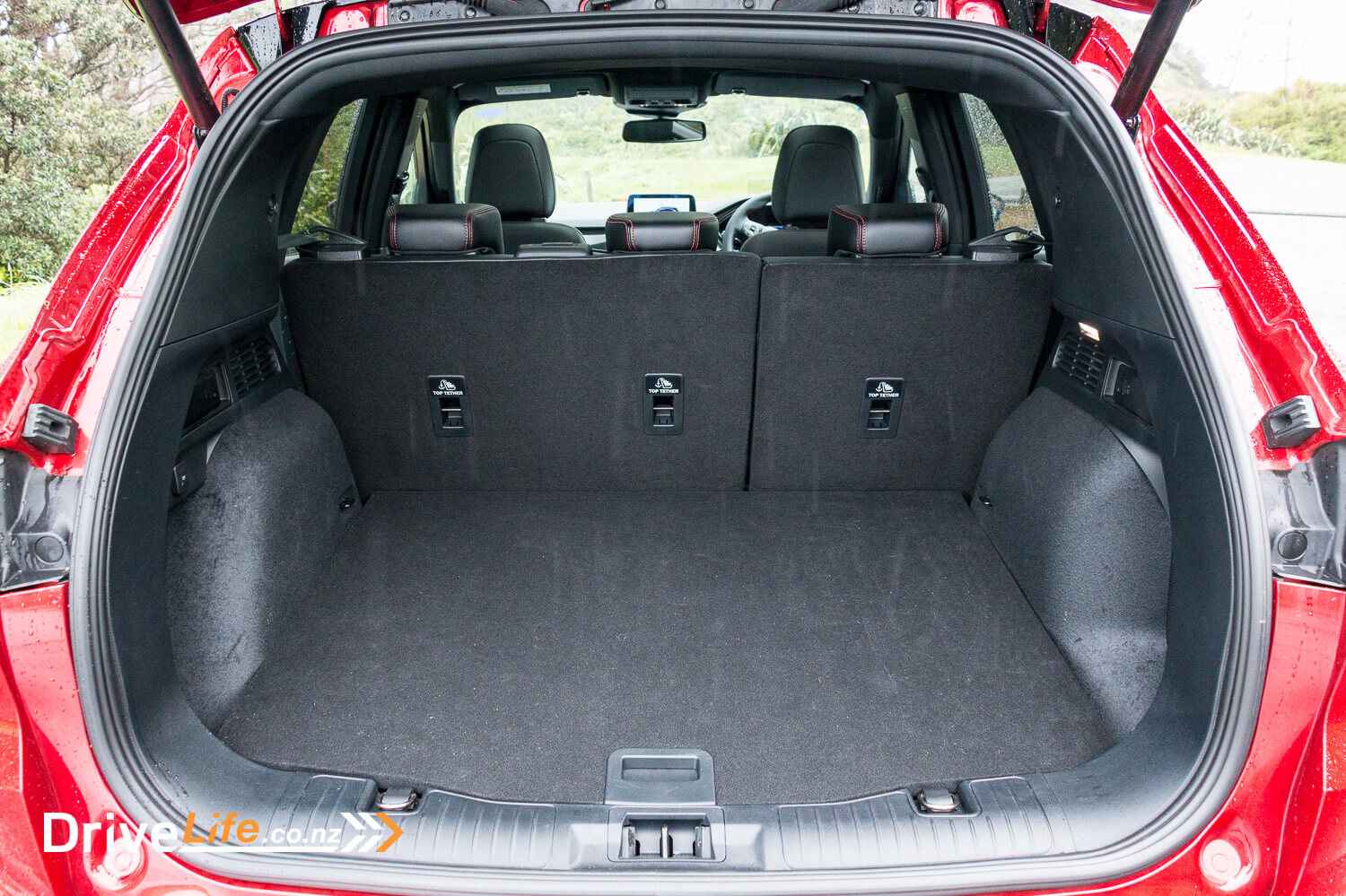
What’s The Interior Like In The Ford Escape ST-Line X PHEV?
Sit in the driver’s seat of the Escape PHEV and the first thing that grabs your attention is the driver’s display with a rather bright and beautiful landscape shot on the welcome screen. It fades to the default fairly standard two-gauge display with a blue backdrop. Speed on the left, power/charge on the right. This can of course be customised with various gauge styles and functions. The lower spec PHEV gets more standard dials and a 4.2” TFT display. Not as fancy! There’s a nice, slightly chunky steering wheel; flat-bottomed and clad in perforated leather. There’s lots of buttons for adjusting the displays, stereo and cruise control, but they’re logically laid-out and easy to use.
There’s a heads-up display too. It’s the pop-up type that projects onto a little transparent screen of its own rather than the windscreen, but it works very well.
The 8” central touch screen is the tacked-on iPad style rather than integrated, but it’s bright and clear, and easy to see and use from both front seats. Under the screen are physical volume knob and track skip buttons – which I like – and also a button to turn on the external cameras. Under the vents are more buttons for heated seats, and knobs with central displays for dual-zone climate control temperature. Simple and easy to use.
The ST-Line X features a 10-speaker B&O sound system and it’s very good, with great bass thanks to a subwoofer in the back.
The gear shifter is a rotary one which is fine to use but can be occasionally fiddly when doing a three-point turn for example, but that’s common to any shift-by-wire system. There are USB A and C sockets, a Qi wireless charger and a 12-volt power socket so you should be able to charge all of your devices easily. The cup holders are the proper size for a Wellington coffee, with space between them so your lids fit properly. They’re lit at night too, which looks cool.
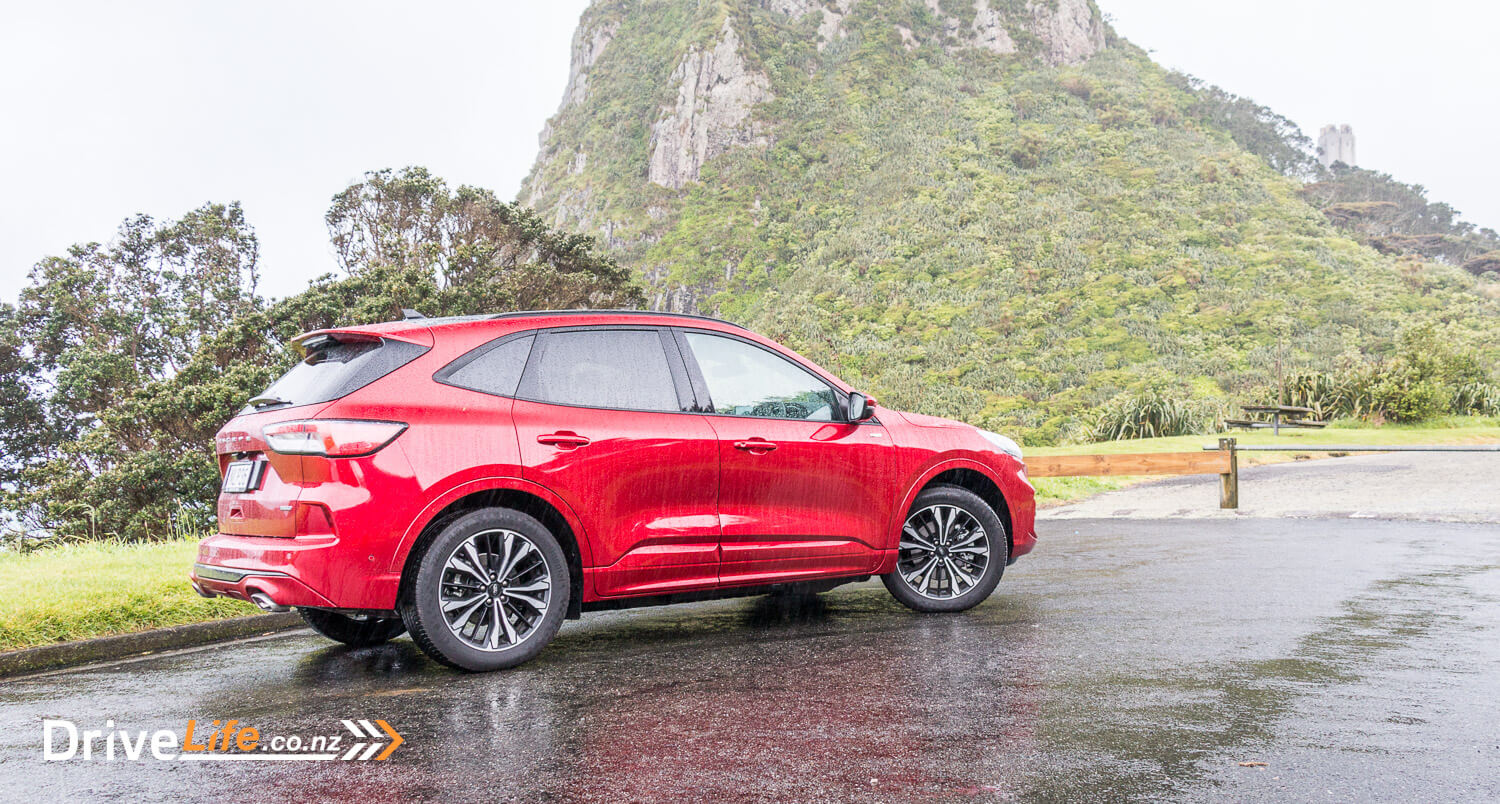
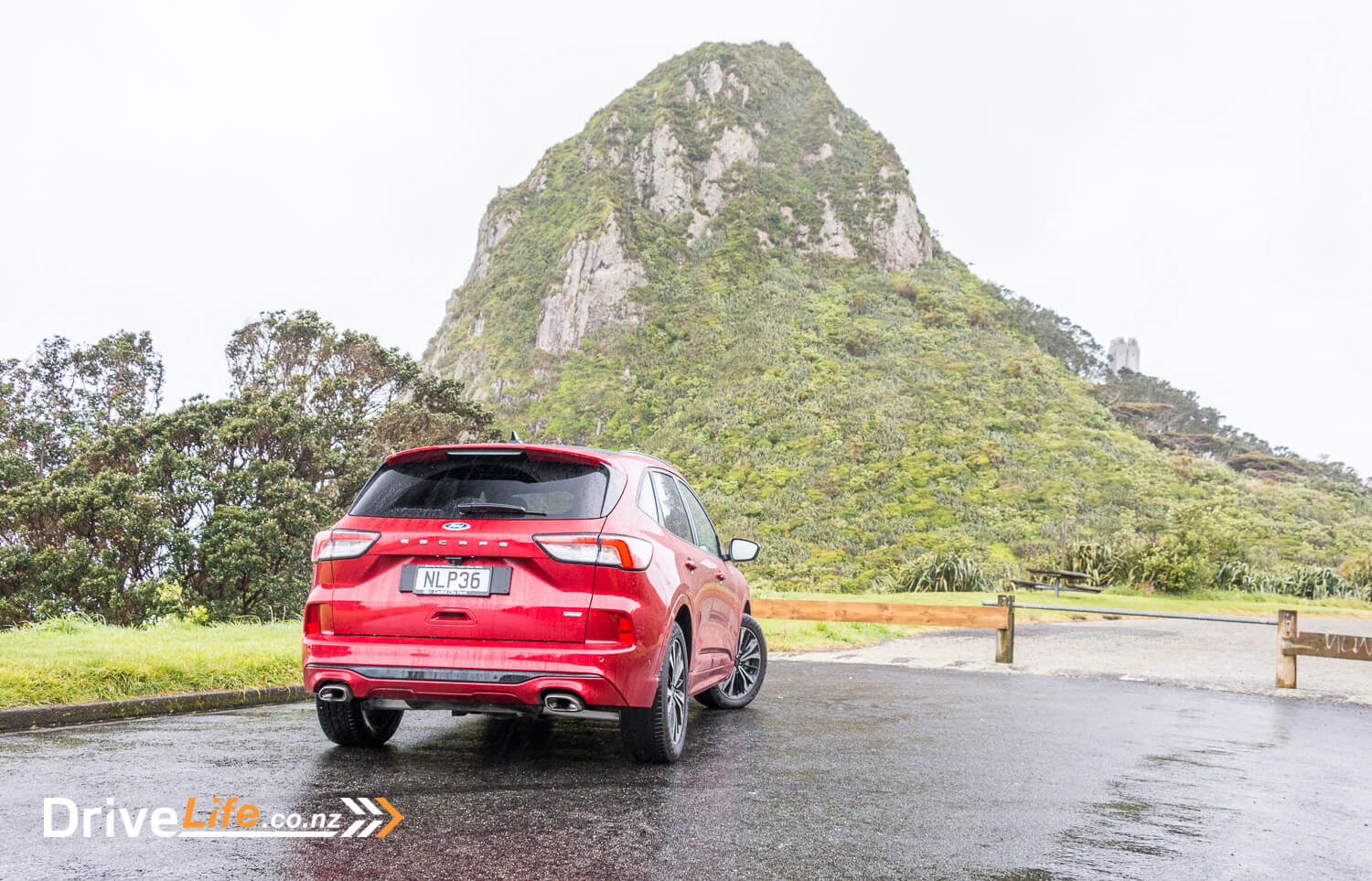
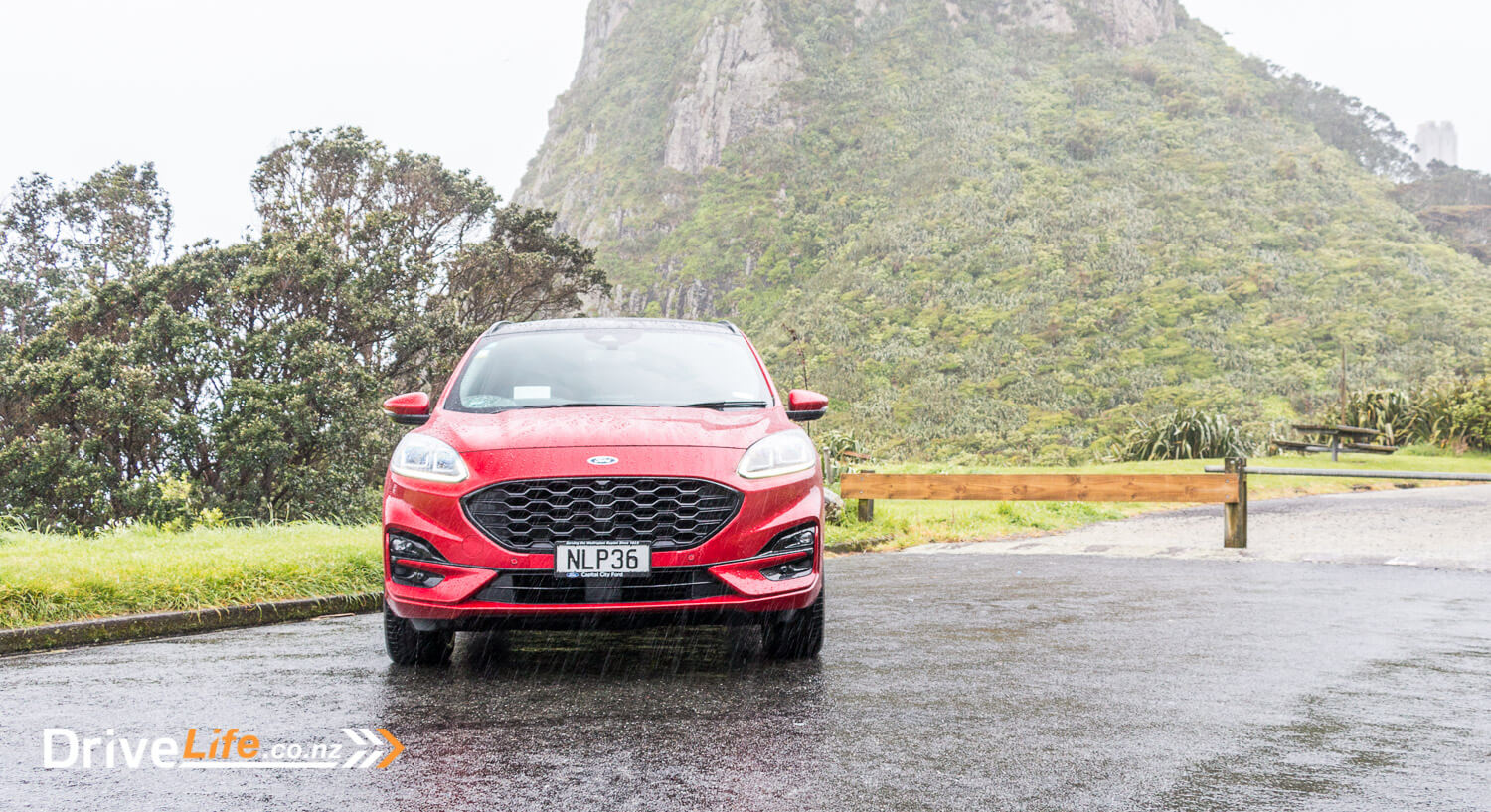
The seats look great, with suedey cloth centres, leather bolsters and red contrasting stitching. They’re firm but very comfortable with no complaints from front or rear on our 800km of weekend driving. Leg room in the back is good, and rear seat passengers get USB ports and their own temperature controls. There’s also the option to gain extra legroom, sacrificing a few cm of boot space by sliding the rear seats back. The back seat is rather pleasant thanks to the full-length glass roof. There’s a motorised cover which can be closed to give a bit more protection from the sun.
At 517 litres, boot space is very good, and easily swallowed our suitcases and gear. The load cover is a bit flimsy – just a thin cloth sheet with wire edges. It does the job, but is easy to knock out of its fastenings, and is very susceptible to Wellington-style windy weather. There’s a kick-to-open (or close) hands-free function on the electric boot, which is always a welcome feature. The boot can also be closed from the remote, which quite a few cars don’t let you do. I like that it plays a little tune when closing rather than a harsh beep like some cars.
One cool feature is the pop-out door protectors. When you open a door, they flip out and around and protect the end of your door, and anything you might hit with it. The Escape isn’t the first car to have these, Skoda had them on the Kodiaq, but they are clever. They do make a little noise as the door closes, which can make you think that the door hasn’t closed properly, but you soon get used to that.
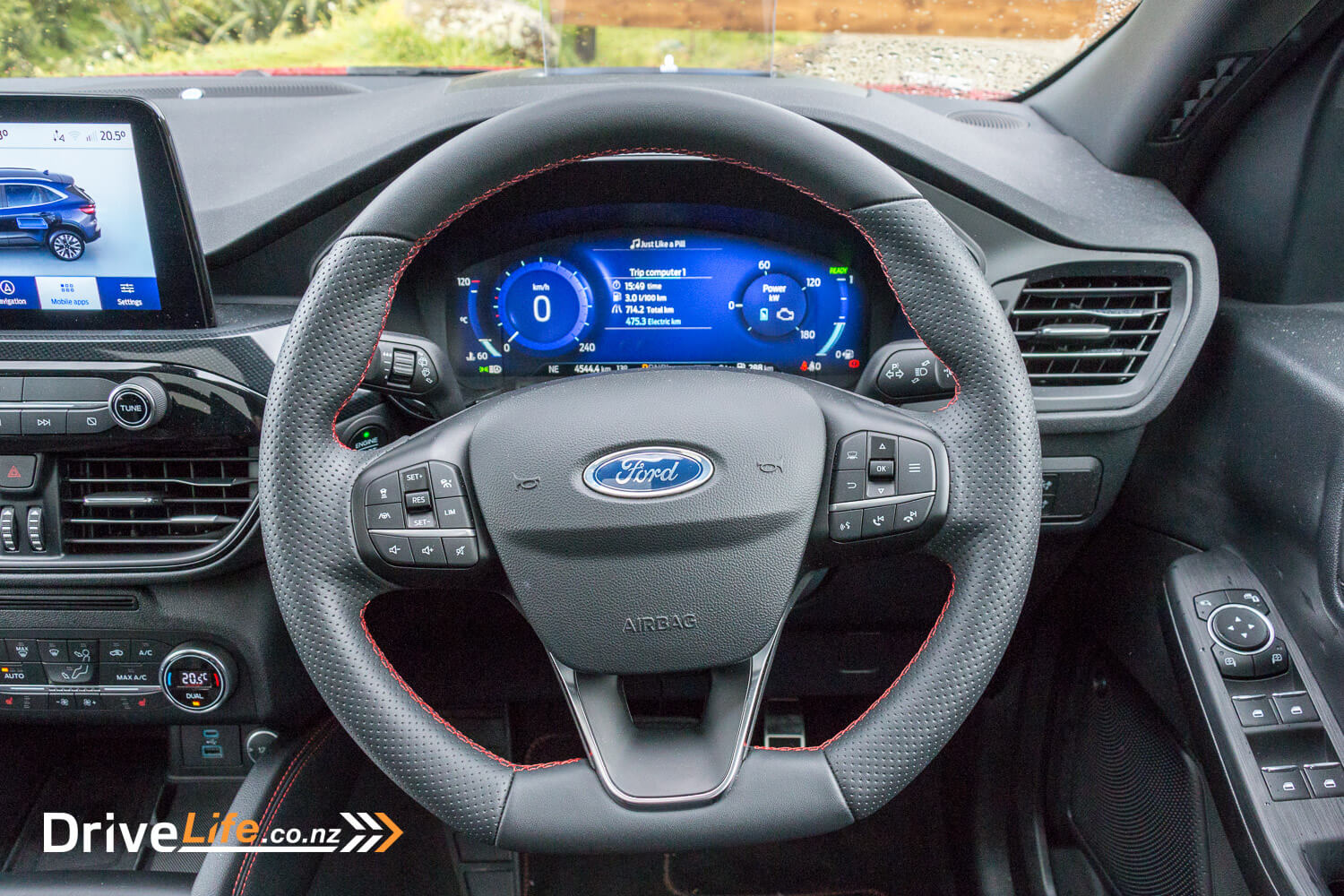
What’s The Ford Escape ST-Line X PHEV Like To Drive?
The Escape is the first electric car or PHEV I’ve tested that both fits in my narrow drive (just!!) and is able to get close enough to my garage to be plugged in, and to shut the garage door. This meant I was able to use it as intended, plugging in the power every time I got home.
You have four EV options with the Escape PHEV – EV Auto, where it decides when the petrol engine comes on, EV Now, which forces it into electric-only until the battery is flat, EV Later, which is petrol only so you can save the battery for later, and EV Charge, which uses the petrol engine to charge the EV battery. This mode setting is retained when you stop and start the engine.
I drove my first 25km on petrol before I was able to charge it, then my first week with the Escape comprised mostly short commutes and school runs, I set it to “EV Now” mode for the whole time. I covered 300km in pure EV mode, bringing the average fuel usage down to 0.7l/100km. As far as I can tell from my home electric app it cost about $1 for each 20km.
We set off from Wellington to Taranaki with a full tank of fuel and a full battery charge, with the Escape set to EV Auto mode. It was a perfectly fine day with beautiful blue skies. Ruapehu was clearly visible on the approach to Sanson, and I’ve never seen Taranaki maunga so clearly before from as far south as Patea. By the time we arrived the clouds were closing in, and as you can see from the photos it became a little moist.
On our trip the Qi phone charger was well-used, though it didn’t like my wife’s iPhone 12 in its protective case, it kept flashing up on the screen that it was misaligned on the charger. No problem as there were two phones to charge, and the Escape has USB-A and C ports in the front.
Ride comfort on all surfaces was very good, with even the roughest chip seal roads not producing too much road noise. That’s particularly important because the drivetrain is so quiet, switching seamlessly and almost unnoticeably between electric and ICE power. The ride comfort doesn’t seem to compromise handling either. The PHEV happily zipped around highway corners without too much body roll, and felt composed and safe at all times.
On the trip we got past Waikanae before the engine had to cut in at all, and even then we were running on electric more than I expected, covering 170km of the 375km trip on pure electric and averaging 4.9l/100km.
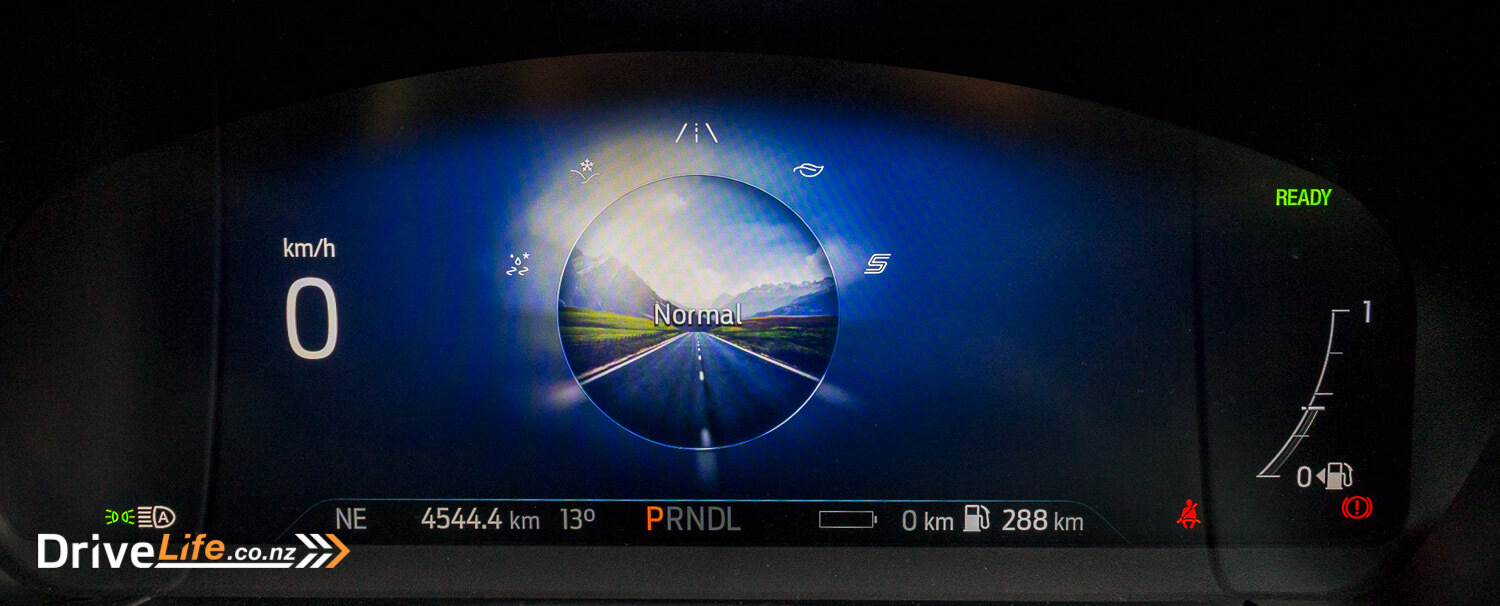
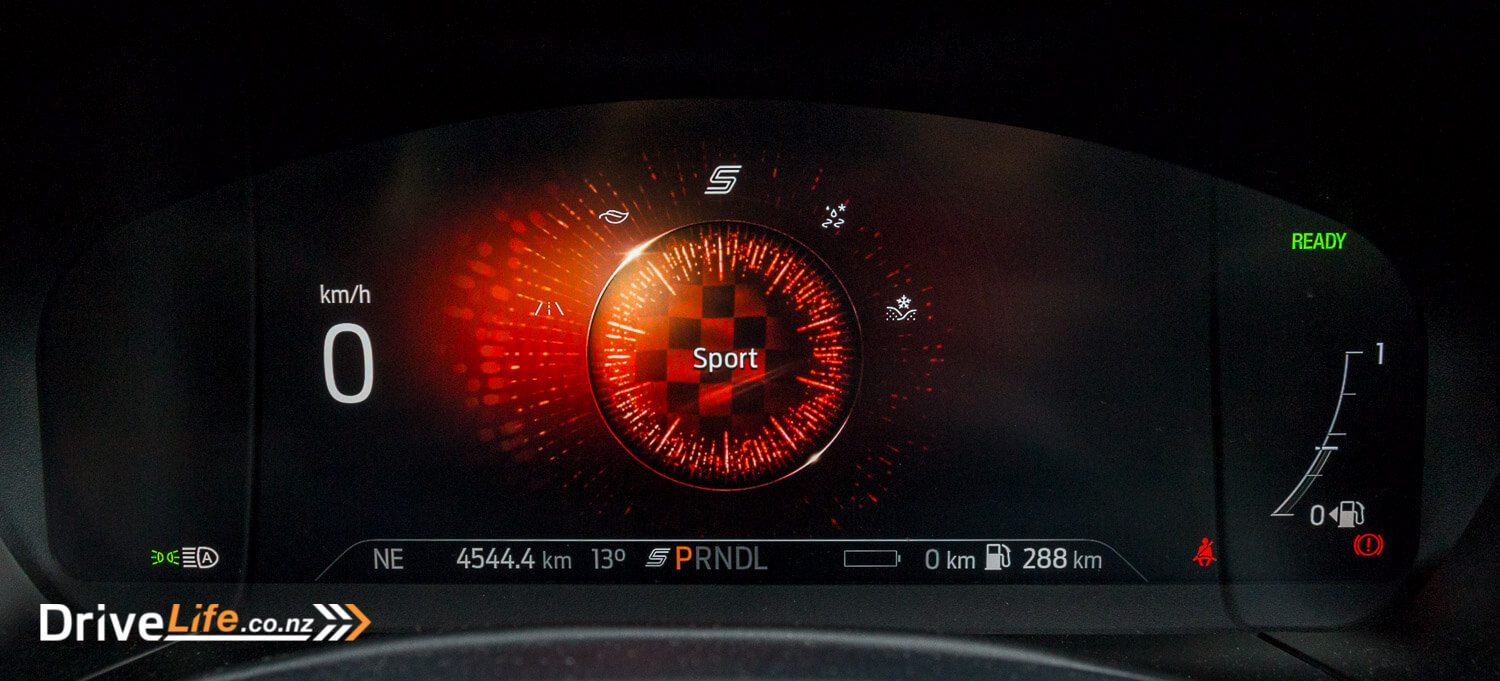
When I went out to look for a photo spot around the outskirts of New Plymouth, I ended up following the satnav back down a series of twisty back roads. The satnav directions are clear, and turn maps are shown on the main screen, HUD and driver’s display so it’s all very easy to follow.
But I digress. The twisty roads. Up to this point I’d been feeling that the Escape PHEV was a perfectly good car but not all that interesting, but the more I drove it on these roads, the more I realised I was enjoying myself. Then I remembered it had Sport mode, and hit that button. In Sport it woke up a little more, with the 2.5-litre 4-cylinder engine always on, and the electric motor filling in more low-down torque, making the already quite eager 167kW petrol engine feel even better. And the handling is very good indeed. You can brake hard into a corner, the regenerative braking adding to the stopping power, chuck it in, and power back out with the electric motor’s help. It’s all rather satisfying and it’s easy to forget you’re in an SUV.
It’s still pretty quiet, and I did find myself adding my own turbo noises as I drove, pretending I was in my classic Audi. There is some engine sound but so much work has gone into making this car quiet that it’s never going to make sports car noises. Still, I was very pleasantly surprised with how much fun it can be.
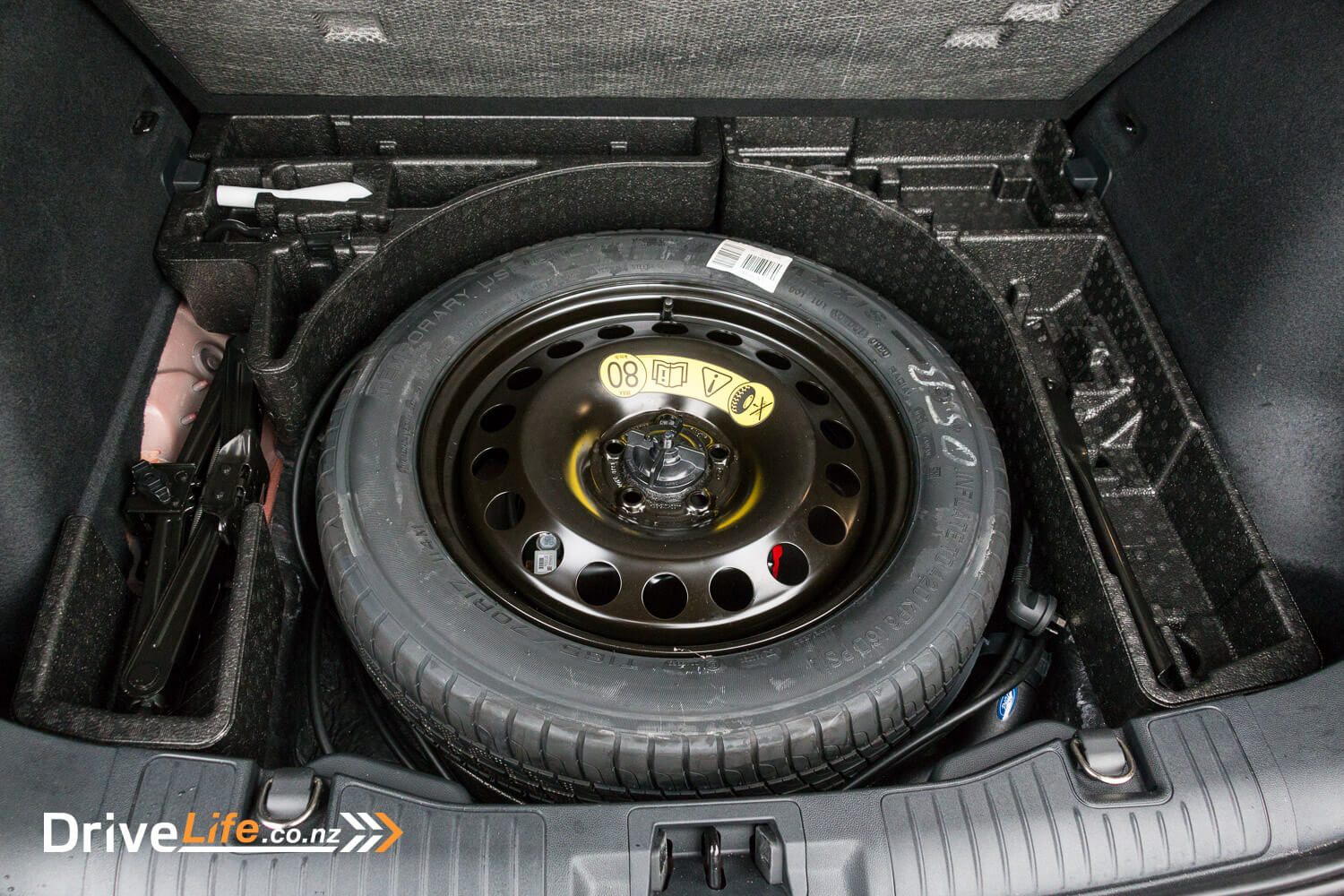
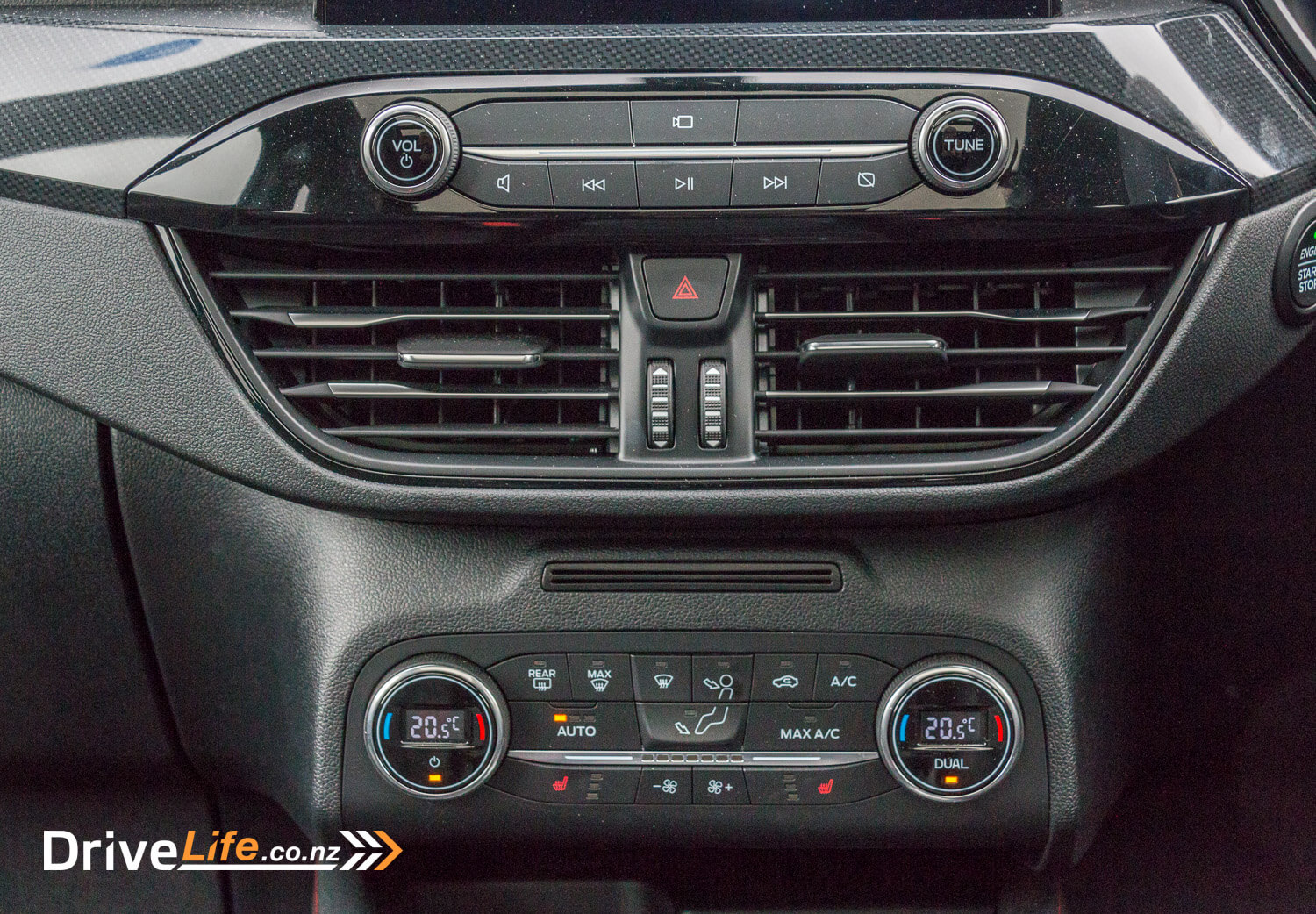
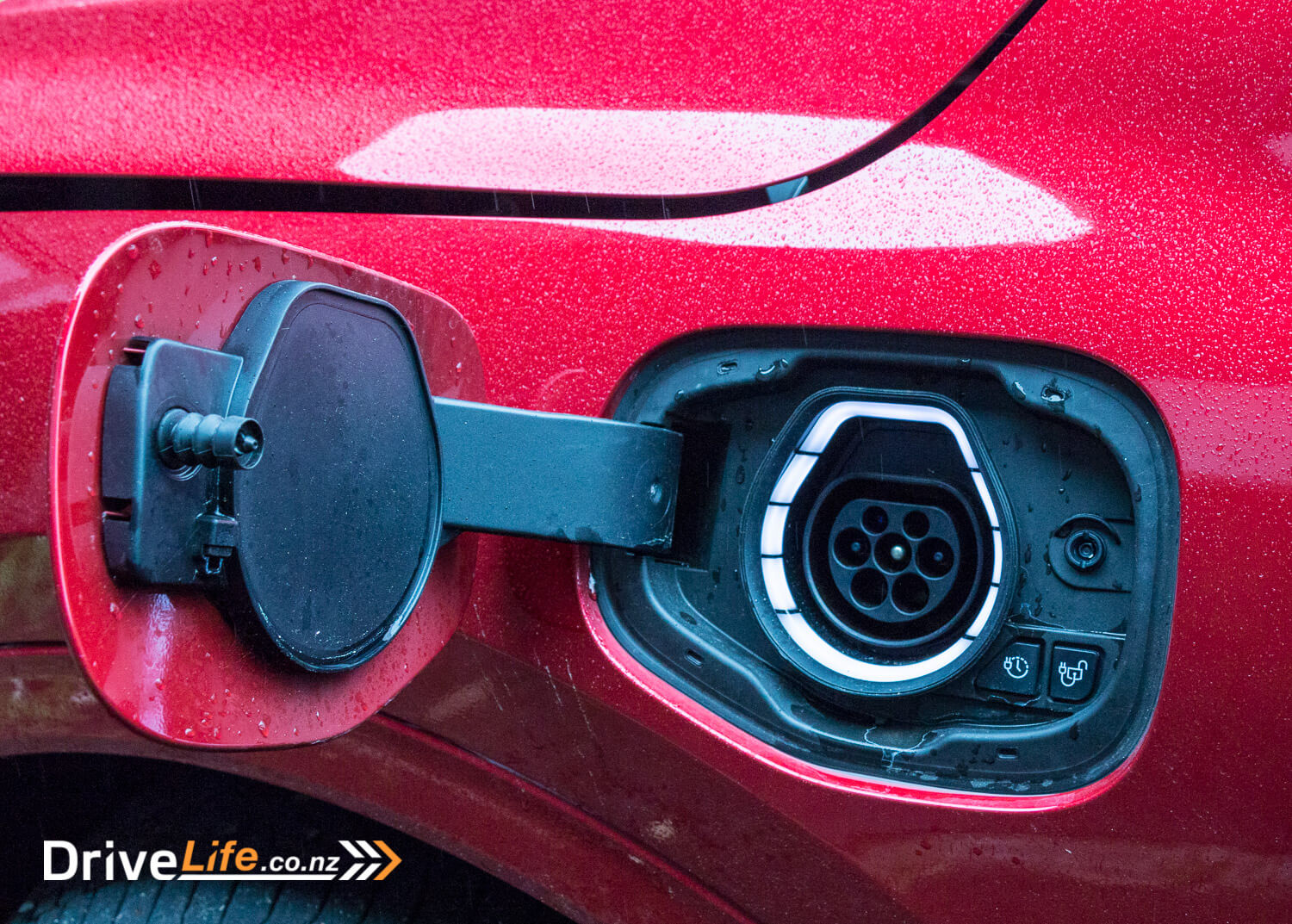
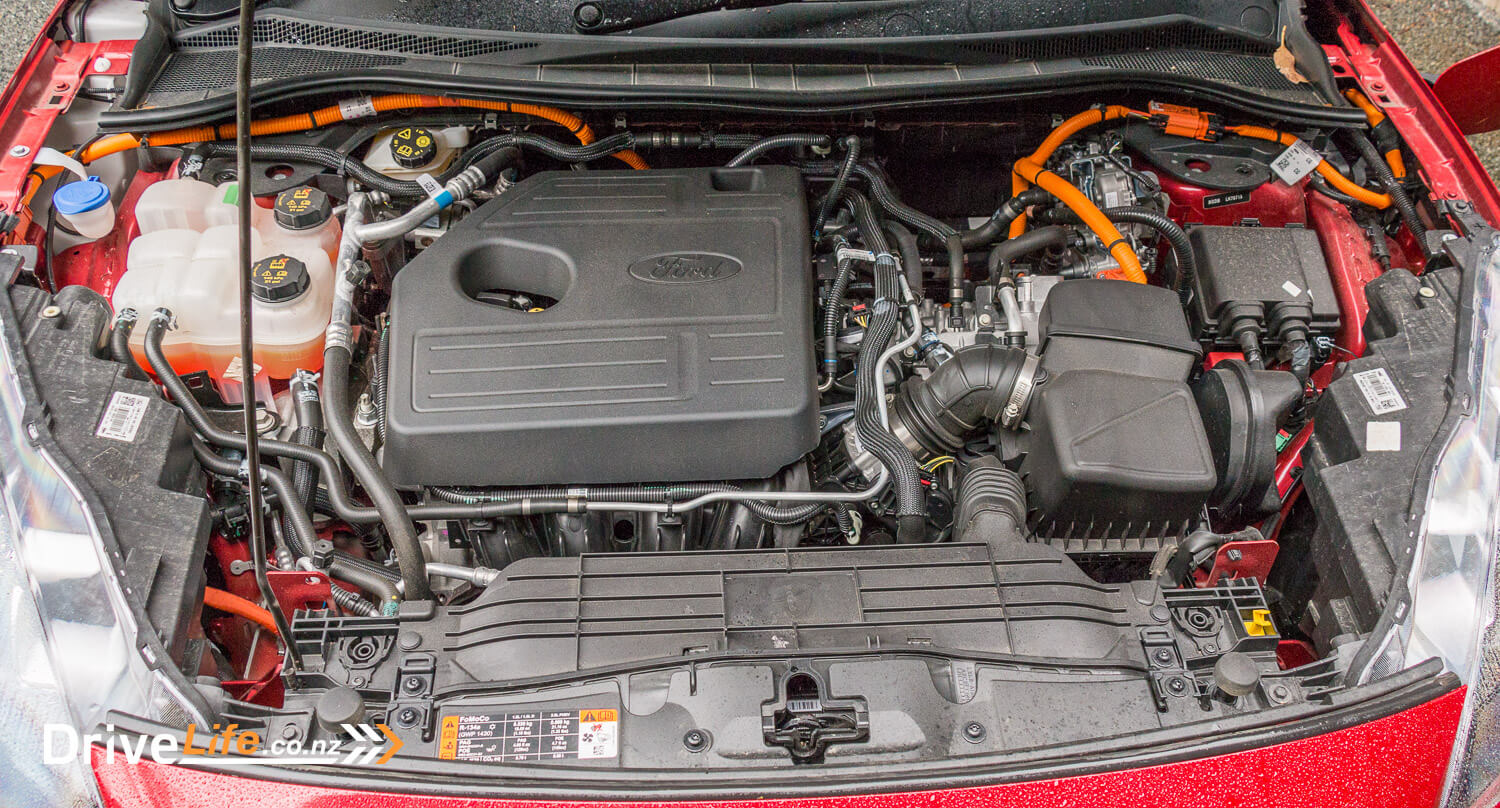
Overall I really liked the Escape PHEV. There were a few little niggles I had. The smart cruise can be a bit jerky and on/off the throttle in stop/start traffic, and sometimes confused by other cars changing lanes. The smart cruise does bring the car to a complete stop. Other manufacturers’ systems are smoother. The regenerative brakes are also a little “grabby” at low speeds and this might be related to the cruise jerkiness. Lastly the auto high-beams are not great, not switching on or off quite when I wanted them to. I turned them off and did it manually in the end. None of these are major issues, overall the Escape is a very comprehensive package.
Over nearly 1,200km, average fuel usage was an impressive 4.1l/100km. This is a bit above Ford’s claim of 1.5l/100km but I have no doubt that if I was using the Escape PHEV in the way I use my daily driver, and plugging in overnight every couple of days, I would achieve less than 1l/100km average.
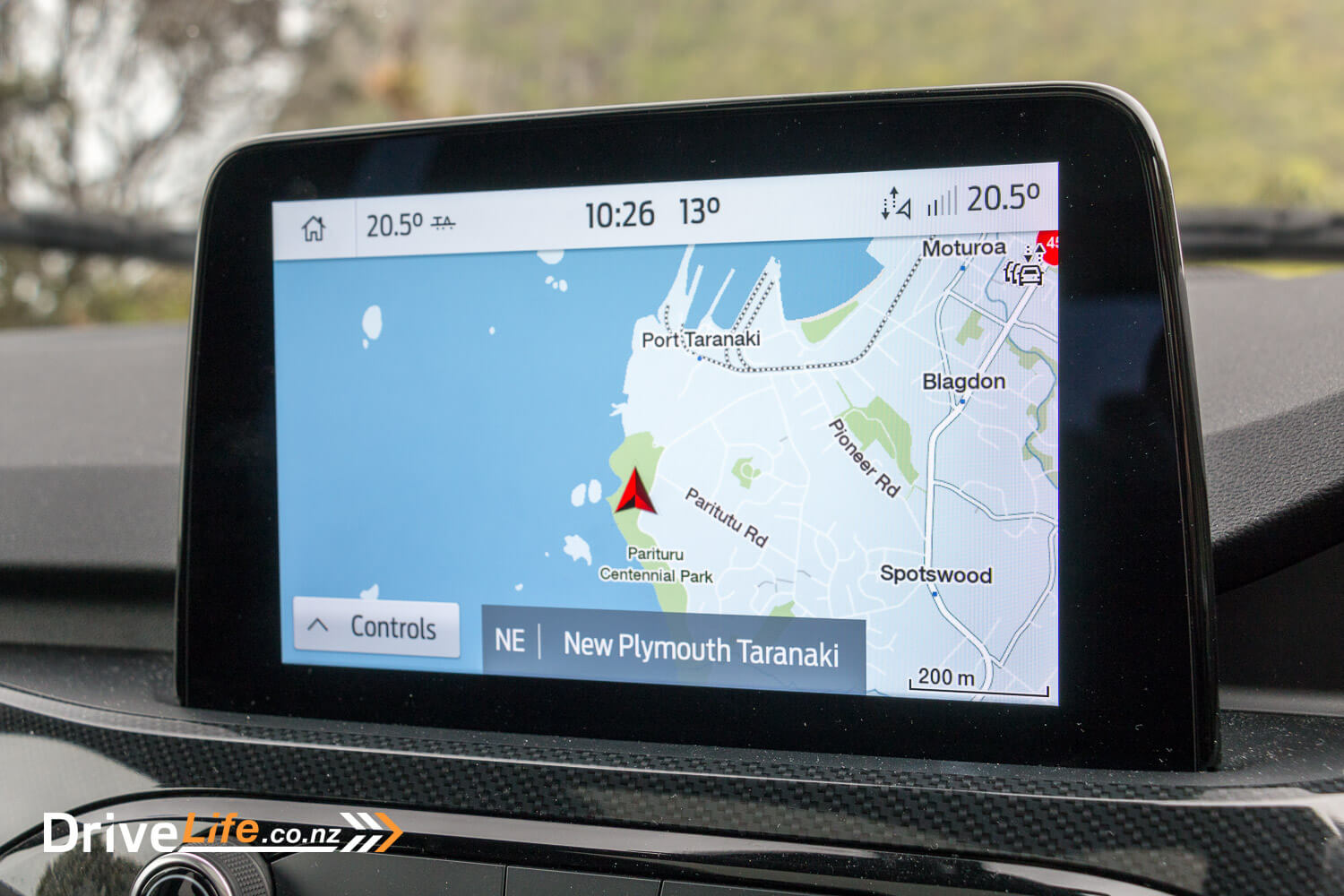
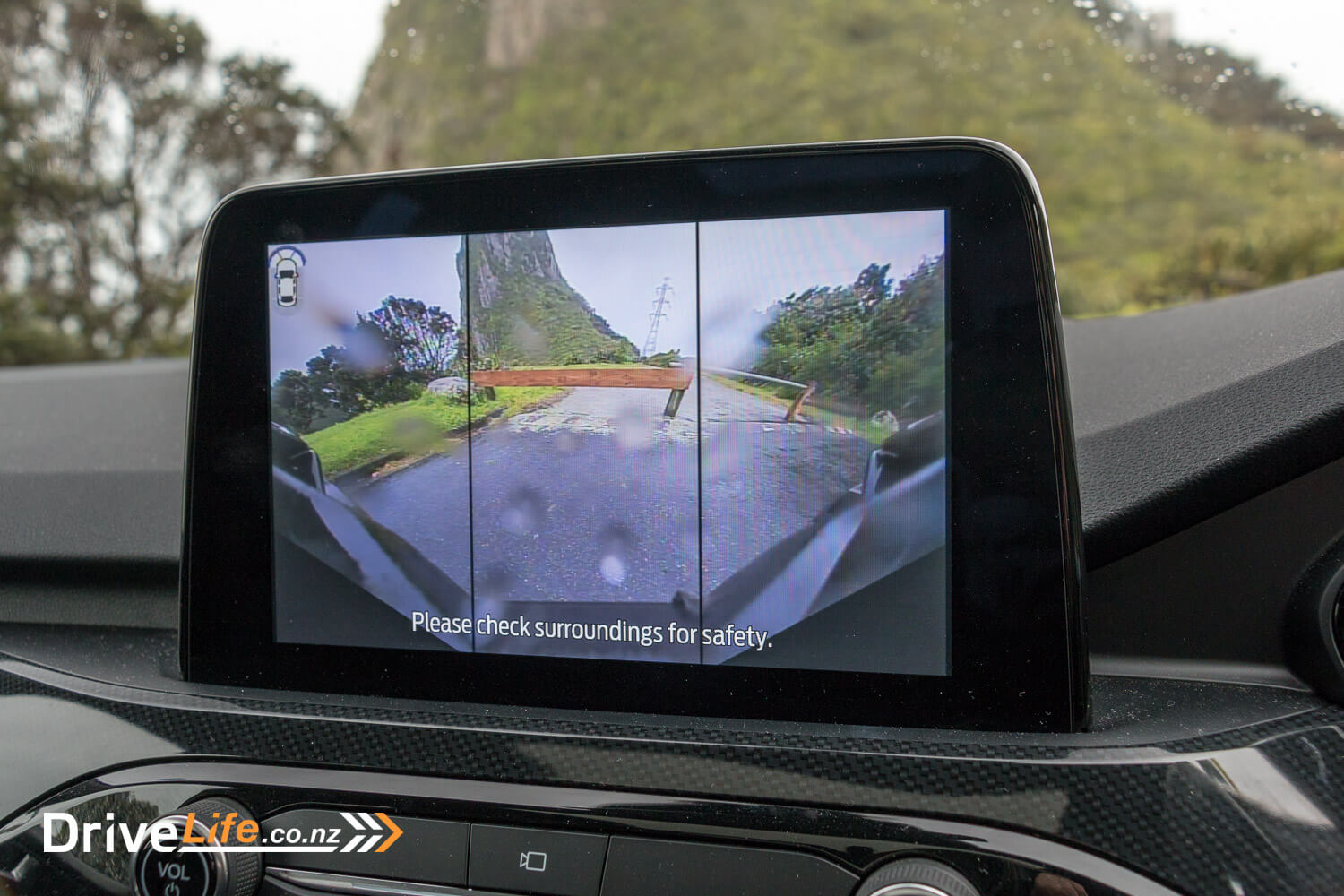
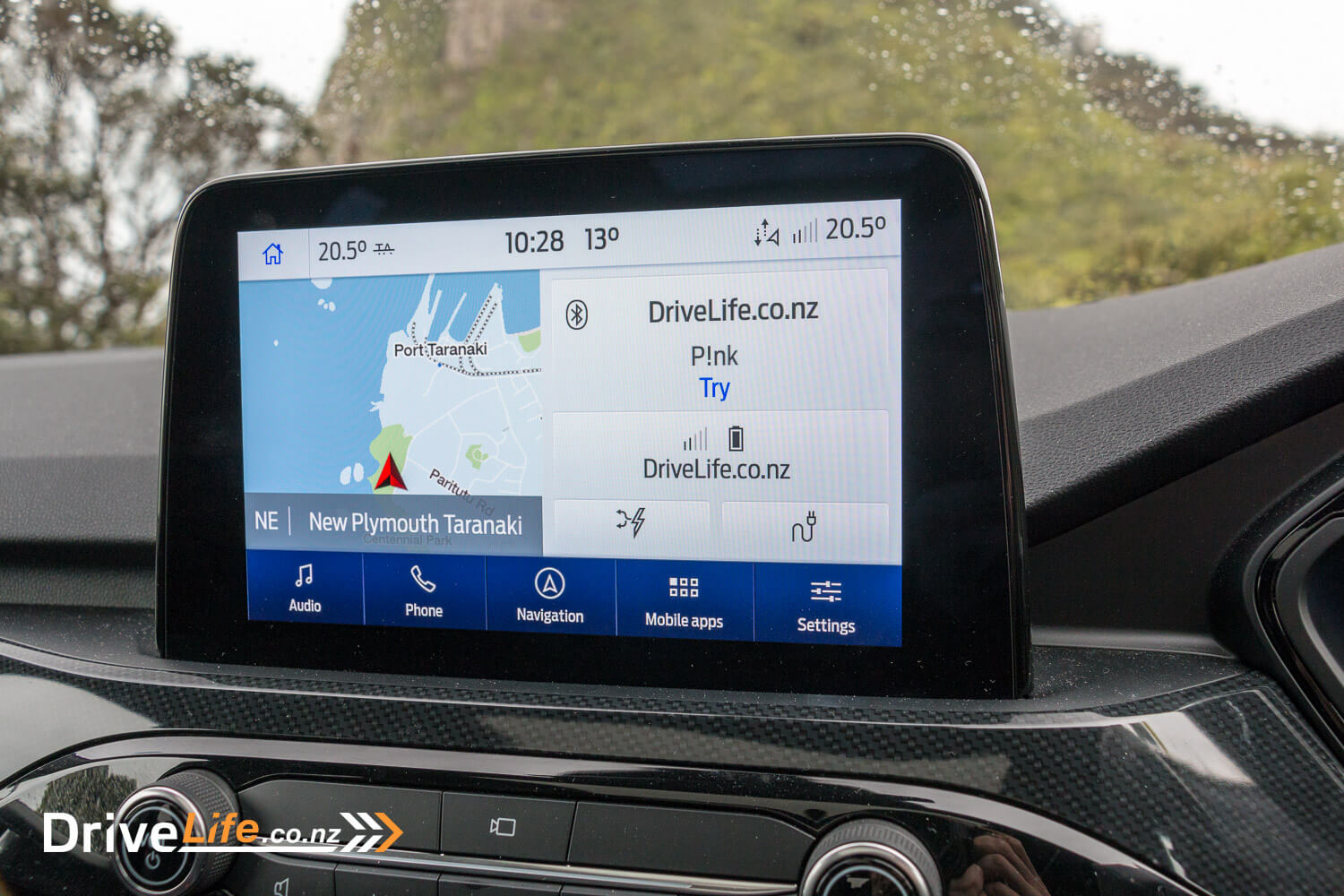
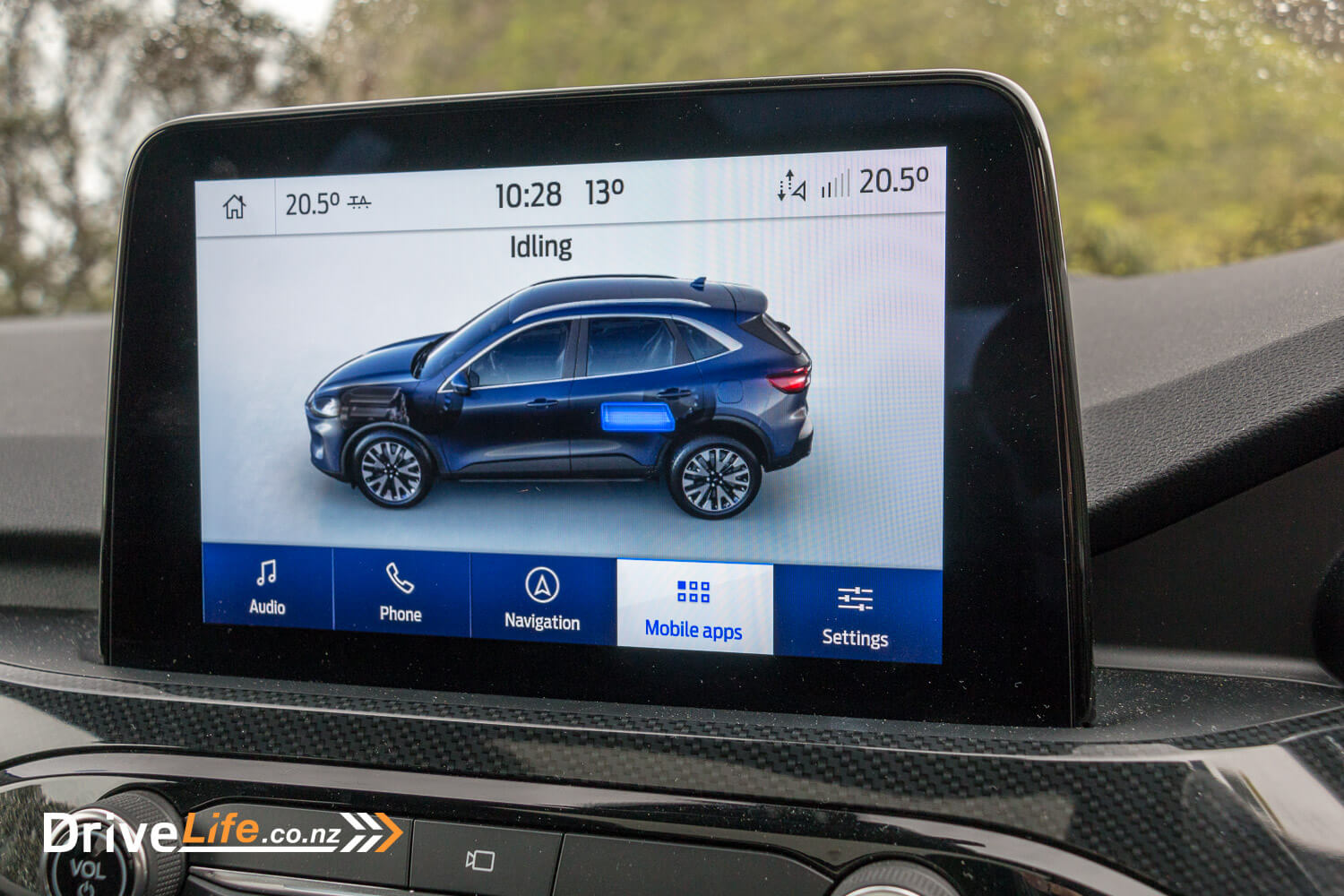
Ford Escape ST-Line X PHEV Specifications
| Vehicle Type | Hybrid SUV |
| Starting Price | $66,990 |
| Price as Tested | $66,990 |
| Engine | 2.5L iVCT Atkinson Cycle I-4 Plug-In Hybrid |
| Power, Torque kW/Nm | 167 Torque not stated |
| Transmission | PowerSplit: eCVT |
| Spare Wheel | 17” space saver |
| Kerb Weight, Kg | 1,843 |
| Length x Width x Height, mm | 4614 x 1883 x 1670 |
| Cargo Capacity, Litres (seats up/seats down) | 517/1423 |
| Fuel tank capacity, litres | 45 |
| Fuel Economy, L/100km | Advertised Spec – Combined – 1.5 Real-World Test – Combined – 4.1 Low Usage: 0-6 / Medium Usage 6-12 / High Usage 12+ |
| Towing Capacity Kg, unbraked/braked | Not stated/1,200 |
| Turning circle, metres | 11.4 Small: 6-10m / Medium 10-12m / Large 12m+ |
| Warranty | 5 year unlimited kilometre warranty 3 year roadside assist 20,00km/12 month service intervals |
| Safety information | ANCAP Rating – 5 stars – Link Rightcar.govt.nz – 5 Stars – NLP36 |
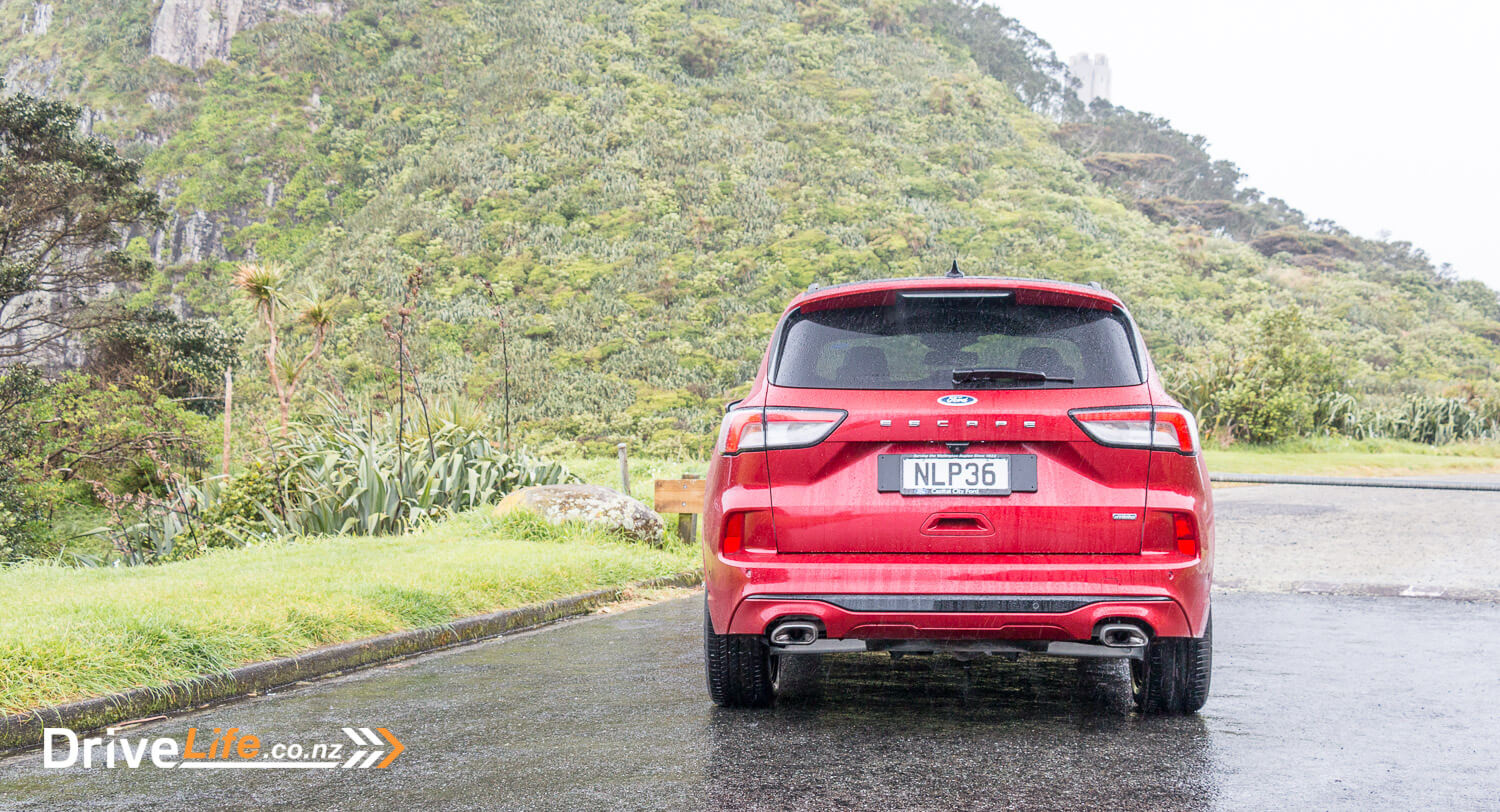


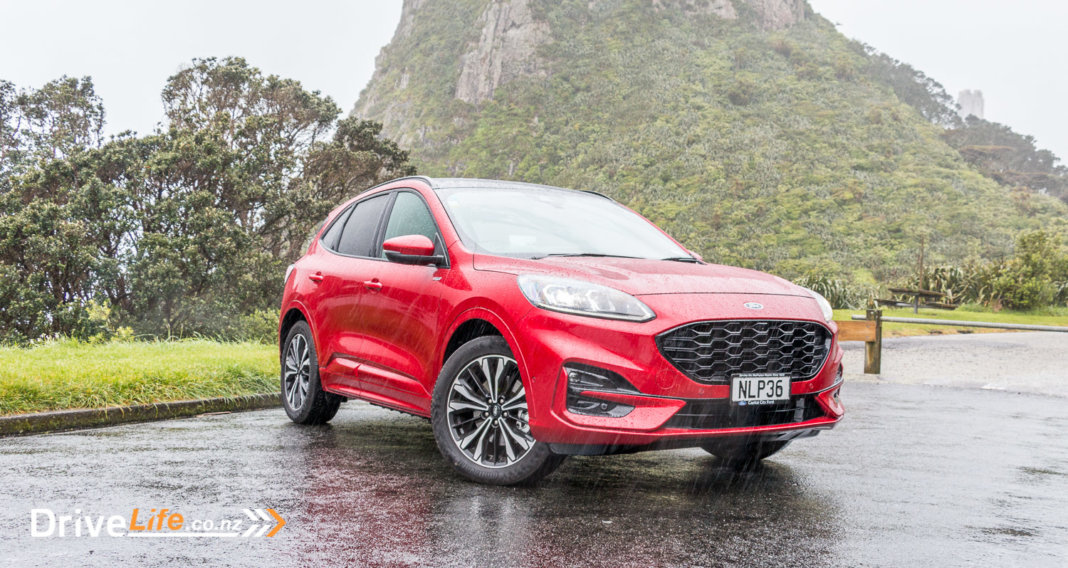






I have only just finished reading your review on the new Ford Escape ST Line. Outstanding this is the best online web site I have found. Thankyou
Of to find my next review to read well done.
Hi Shane, thanks for your comments and I’m glad you’re enjoying our reviews.
Morning Rob,
Great review for a family SUV. Helps a lot on research work while planning to buy the next one.
A difficult situation to address, but a bit of insight into reliability would be an added bonus. Completely understand that the vehicle is new to the market thou!